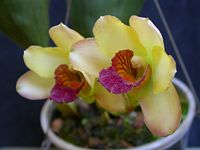Bifrenaria
| Bifrenaria | ||||||||||||||||||||
|---|---|---|---|---|---|---|---|---|---|---|---|---|---|---|---|---|---|---|---|---|
 Bifrenaria harrisoniae
| ||||||||||||||||||||
| Scientific classification | ||||||||||||||||||||
| ||||||||||||||||||||
| Type species | ||||||||||||||||||||
| Bifrenaria atropurpurea Lindl. 1832 | ||||||||||||||||||||
| Species | ||||||||||||||||||||
| ||||||||||||||||||||
| Synonyms | ||||||||||||||||||||
Bifrenaria is a genus of Orchids formed by twenty species of South America, some among the favorites of orchid growers because of their abundant showy flowers, which are large and very fleshy and at first glance seem artificial flowers made of wax. There are no known uses for them other than ornamental.
Despite the low number of species, they can be split in two clearly distinct groups:[1] one of highly robust plants with large flowers, that encompass the first species to be classified under the genus Bifrenaria; other of more delicate plants with smaller flowers occasionally denominated Stenocoryne or Adipe. There are yet two other species that normally are classified as Bifrenaria but which molecular analysis indicate to belong to different orchid groups. They are Bifrenaria grandis, endemic of Bolívia, which many taxonomists denominate Lacaena grandis,[2] and Bifrenaria steyermarkii, inhabitant of northern Amazon Forest,[3] which does not have an alternative classification as yet.
Distribution
Bifrenaria exist from the north of South America, one species reaching Trinidad, until Rio Grande do Sul, the farther south State in Brazil, however they are split in two isolated areas:[4] Amazon Forest and Atlantic Forest of Brazil. The later, where seventeen species are present, may be considered their recente center of distribution. The montane area of Rio de Janeiro State and Espírito Santo is particularly rich with fifteen species registered. Serra dos Órgãos mountains area, in Rio, is reported as habitat of fourteen Bifrenaria species,[5] however, some of these species are considered synonyms today,[6] being eleven a more realistic number of species existing in the said area.
The species with large flowers are more common on Region Southeast of Brazil, however, they inhabit from the sunnier areas of the seashore to rocky mountain areas of Minas Gerais e Bahia States, from almost sea level up to 2,000 meters of altitude, some species reaching Rio Grande do Sul state.[7] No species of large flowers exist in Amazon Forest. Some species grow directly attached to the famous Sugarloaf Mountain in Rio de Janeiro which can be observed by the commuters in the cable car. The recent centers of irradiation of this group are the seashore close to Serra do Mar chain of mountains, and the high chains of moutains of Minas Gerais.[8] The most common species in this group, spread from Rio Grande do Sul to Bahia, is B. harrisoniae.[9]
References
- ↑ Cogniaux, Celestin A.(1902). Bifrenaria in Flora Brasiliensis K.F.P.von Martius & auct. suc. (eds.) vol.3 p. 5: 476. published on Internet.
- ↑ Kraenzlin, Friedrich Wilhelm Ludwig (1928). Lacaena grandis in Repertorium specierum novarum regni vegetabilis. Ed. Selbstverlag des Herausgebers, Berlin, at vol.25: 25.
- ↑ Dunsterville, Galfried Clement Keyworth & Garay, Leslie A. (1976). Bifrenaria steyermarkii in Venezuelan Orchids Illustrated vol.6: 56. London.
- ↑ R. Govaerts, M.A. Campacci (Brazil, 2005), D. Holland Baptista (Brazil, 2005), P.Cribb (K, 2003), Alex George (K, 2003), K.Kreuz (2004, Europe), J.Wood (K, 2003, Europe) (Novembro 2008). World Checklist of Orchidaceae. The Board of Trustees of the Royal Botanic Gardens, Kew. Published on the Internet. (Access March 2009).
- ↑ Miller, David , Richard Warren, Izabel Moura Miller & Helmut Seehawer (2006). Serra dos Órgãos sua história e suas orquídeas. Rio de Janeiro.
- ↑ Koehler, S. & do Amaral, M.D.E. (2004). A taxonomic study of the South american genus Bifrenaria Lindl. (Orchidaceae). Brittonia 56: 314-345.
- ↑ Castro Neto, Vitorino P. (2006). Bifrenaria atropurpurea in Icones Orchidacearum Brasilienses. ISBN 8590149447
- ↑ Frederico C. Hoehne (1953). Bifrenaria in Flora Brasílica, Vol 12: 7. Instituto de Botânica de São Paulo.
- ↑ Castro Neto, Vitorino P. (2006). Bifrenaria harrisoniae in Icones Orchidacearum Brasilienses. ISBN 8590149447